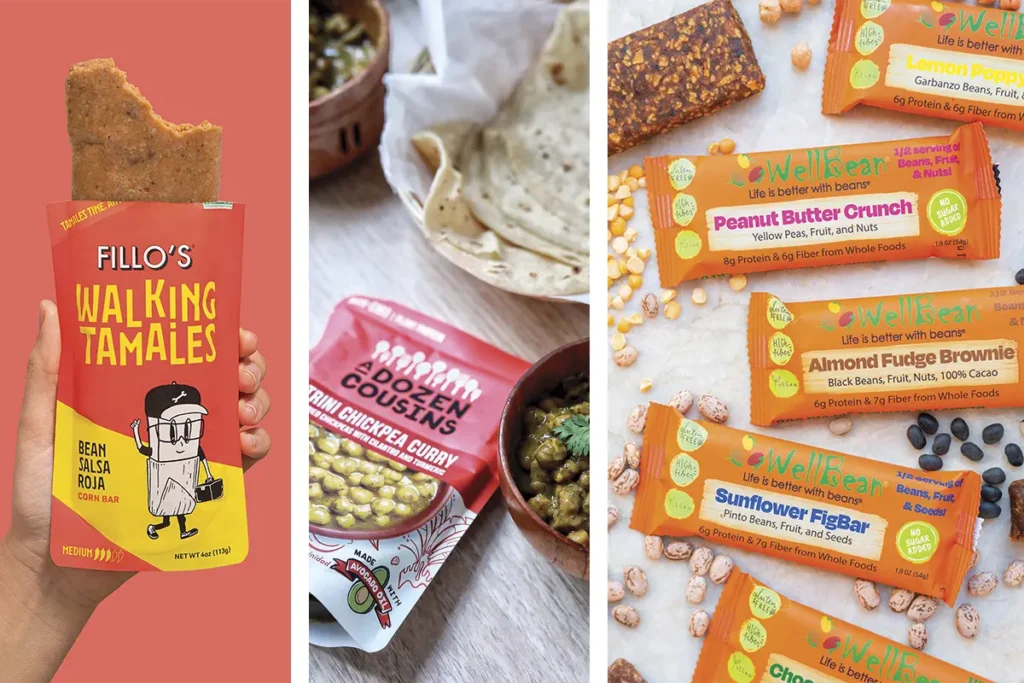Today’s Dietitian
Vol. 27 No. 5 P. 42
Pulses are being reimagined in new and exciting ways across grocery shelves and restaurant menus, and have become a favorite ingredient on TikTok—from dense bean salads and brothy beans to bean dips and black bean brownies.
That’s a good thing, since we all need to be eating more beans, dry peas, lentils, and chickpeas—2.5 cups per week, according to the 2025 Dietary Guidelines for Americans scientific report.1 Pulses perform double duty as a vegetable and protein source, and the guidelines recommend that pulses stand in more often for red and processed meat.
Beans and other pulses are not only nutrient-dense but they have a strong sustainability story as well.2
“Pulses have the unique ability to fix atmospheric nitrogen in the soil, which improves soil health and reduces the need for synthetic fertilizers,” says Chris Vogliano, PhD, RDN, director of global research at Food + Planet.
“As a climate-smart protein with minimal water use, pulses support both human and planetary health,” he says.
Pulses are plant-based foods that connect to every culture in the world, including all five Blue Zones, or regions in the world where people live the longest. Pulses are also affordable and incredibly versatile.
New Pulse Product Trends
While pulses have long been available in convenient forms—from canned beans, soups, and chili to frozen bean burgers and burritos—we’re seeing an explosion of new pulse-based innovations.
Maybe you’ve seen the increased availability of gluten-free pastas made with chickpeas, lentils, black beans, and edamame. Pea protein has become a popular ingredient in plant-based dairy substitute products, meat alternatives, bakery products, and protein drinks.
Aquafaba, the viscous liquid from cooked chickpeas, has gained prominence as a plant-based egg substitute and is being used in everything from vegan mayonnaise to meringue, mousse, and marshmallows.
The most significant area of innovation—and one that will make it easier to meet the goal of 1/2 cup of pulses per day—are the creative, flavor-forward products that elevate the humble bean beyond a side dish and straight to the center of the plate.
“The demand for pulse-based food products continues to grow, driven by their exceptional nutritional profile and sustainability benefits,” says Ewa Pietrysiak, PhD, director of marketing and innovation for the USA Dry Pea & Lentil Council and American Pulse Association.
“With one in five US product launches now including pulse ingredients, it’s clear that pulses are becoming a staple in food formulations,” she says. Take a look at how some companies are capitalizing on this trend and innovating with this staple food.
Flavorful Canned Bean Meal Starters
Canned beans have always been a convenient ingredient for use in a range of recipes, but now the beans are amped up with flavor and trendy applications are promoted—including grain bowls, lettuce wraps, and warm, creamy curries.
• Heyday Canning Co: This California-based startup went viral on TikTok and has found success nationwide with their bold, contemporary branding and creative ingredients, including kimchi sesame navy beans, tomato a la vodka cannellini beans, enchilada black beans, harissa lemon chickpeas, and coconut curry chickpeas.
• Serious Bean Co: Even baked beans are being reimagined with flavors like Hot Honey, Dr Pepper, Sweet & Smoky Chipotle, Buckin’ Buffalo, Carolina Gold BBQ, and Jalapeno & Bacon, along with recipes to make them the star of the meal.
Globally Inspired Beans in Pouches
Shelf-stable pouches are the latest packaging for preseasoned cooked beans that are ready to microwave for a quick meal. Many of these heat-and-eat beans are globally inspired based on the heritage of the founders.
• A Dozen Cousins: These ready-to-eat seasoned beans are inspired by Creole, Caribbean, and Latin American cooking. Ibraheem Basir, founder and CEO, says he started A Dozen Cousins so it would be easier to enjoy cultural recipes made with wholesome ingredients. Varieties include Mexican pinto beans, Cuban black beans, Trini chickpea curry, refried pinto, and black beans.
• Fillo’s: Two brothers originally from Cuba founded Fillo’s, named for their father, because they couldn’t find their favorite beans from childhood, and lacked time to make the long-simmered legumes. They created a convenient version of these Latin staples flavored with sofrito—diced aromatic vegetables like onions, garlic, and bell peppers with herbs, spices, and olive oil. Flavors of the shelf-stable pouches include Cuban Black Beans Sofrito, Peruvian Lentils Sofrito, Puerto Rican Pink Beans Sofrito, and Mexican Mayocoba Sofrito. For beans on the go, Fillo’s introduced Walking Tamales in shelf-stable, ready-to-eat pouches made with pinto, mayocoba, and black beans.
• SOMOS: A group of three friends who grew up in Mexico loving their mothers’ home cooking created this brand that includes Mexican black beans, pinto and black beans, chipotle refried black beans, and Mexican peacadillo taco filling that swaps pea protein for the ground beef.
• Brooklyn Delhi: Cookbook author Chitra Agrawal, a first-generation Indian-American, created this line of heat-and-eat meals inspired by her parents’ recipes, including Chickpea Tikka Masala, Black Bean Butter Masala, Sweet Potato Coconut Dal With Red Lentils, and Red Bean Rajma Masala.
Instant Lentil Meals
Lentils just got incredibly convenient with these single-serve cups of flavored instant lentils that you simply add water to.
• Lentiful: Ben and Brooke Bacon created this line of instant lentils after cooking a neglected bag of lentils from their pantry. They wanted to help others discover the deliciousness of lentils, which they describe as “flavor chameleons” that absorb the spices and ingredients you cook them with to create an endless array of craveable plant-based meals. Flavors include Mexican Green Chile, Thai Coconut Curry, French Mirepoix, Homestyle Chili, and Pineapple “Chorizo” (smoky vegan lentils with a chorizo-type flavor).
• Aahana’s: This line of Indian-inspired instant lentils was created by Sonal Khakhar, who worked as a clinical and school dietitian in India before moving to the United States. The brand’s name translates to “inner happiness,” which is how she describes her mission to promote well-being with these nourishing, simple foods. Products include Bombay Masala Rice and Lentil Bowl, Jaipur Millet and Lentil Bowl, and Madras Quinoa and Lentil Bowl.
Pulse-Based Snacks
Beyond main dish options, pulses are showing up in a variety of snacks—from crunchy chips to creamy dips.
• Crunchy pulse chips: Biena Snacks, Beanitos, Hippeas, and Enjoy Life offer pulse-based alternatives to potato and tortilla chips made with chickpeas, lentils, black beans, and white beans.
• Puffed pulse snacks: PeaTos and Hippeas produce airy, grain-free puffs in a variety of flavors like Churro, Mexican Street Corn, Fiery Lime, and Nacho Vibes.
• Sweet and savory roasted chickpeas: The Good Bean, Saffron Road, Biena, and Lebby offer a variety of roasted chickpea snacks such as Sweet Sriracha, Chili Lime, Bombay Spice, Honey Roasted, and chocolate coated.
• Bean protein bars: WellBean makes flavored protein bars with pinto beans, navy beans, chickpeas, black beans, and yellow peas.
• Pulse dips and spreads: Hummus may be the most famous pulse-based dip, traditionally made with chickpeas. Now, Lantana offers hummus made with black beans, yellow lentils, white beans, and edamame. Brami makes a hummus with lupini, a yellow legume that’s popular throughout the Mediterranean.
— Janet Helm, MS, RDN, is a global food analyst and public relations strategist with 20+ years agency experience working with food and beverage brands and agricultural commodity boards. She started her own consultancy Food at the Helm and is a sought-after speaker on food trends.
Resources and Recipes
For more information on pulses, including recipes, scientific research, and education materials, consider the following resources:
• USA Dry Pea and Lentil Council, American Pulse Association: USAPulses.org;
• Beans is How, a campaign to double global bean consumption by 2028: sdg2advocacyhub.org;
• The Bean Institute: BeanInstitute.com; and
• Canned Beans: CannedBeans.org.
References
1. US Department of Health and Human Services, US Department of Agriculture. Scientific Report of the 2025 Dietary Guidelines Advisory Committee: Advisory Report to the Secretary of Health and Human Services and Secretary of Agriculture. https://www.dietaryguidelines.gov/sites/default/files/2024-12/Scientific_Report_of_the_2025_Dietary_Guidelines_Advisory_Committee_508c.pdf. Published 2024.
2. Lisciani S, Marconi S, Le Donne C, et al. Legumes and common beans in sustainable diets: nutritional quality, environmental benefits, spread and use in food preparations. Front Nutr. 2024;11:1385232.



